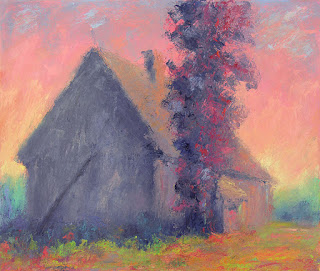
I try to work on my art every day. I decided many years ago to make it one of my top priorities (along with my family and my health) so it's usually other things - household chores and maintenance, returning phone calls, hobbies, reading, etc. - that get neglected or relegated to those infrequent moments when I have "free time". When I am immersed in a painting, I tend to become obsessive and highly focused for the days or weeks required to finish the work, spending many hours per day in the studio and not getting anywhere near the amount of sleep that I should get. This is due, in part, to my personality, as well as my process, which involves spending several days just mixing the colors for a specific painting before I begin actually painting, and requires that I keep working before the paint dries. These periods of focused work can be both physically and mentally exhausting (not to mention demoralizing!) and I usually need at least a week or more in between paintings to recuperate and to catch up on any pressing matters that were neglected whilst I focused on the painting.
During these respite periods, I still continue to work on my art, but in other, slightly less stressful ways. I believe that success in any creative endeavor requires disciplined study and practice balanced with intuition, exploration and risk-taking. Work and Play in equal measure. Exercise the right brain as well as the left brain.
Thus, during the periods when I'm not engaged with a painting, I use the time to both develop my craft and also to generate new ideas. Depending on my mood, I may engage in gesture drawing or other drawing exercises, create detailed, objective renderings from direct observation, learn to use a new media or technique, mix every possible permutation of a particular color or color pairing, transcribe works by the masters or simply read and study, all of which are geared toward developing my technique and knowledge. On other days, in order to develop my creativity, I will immerse myself in much more playful activities which involve working without any preconceptions or plan. Oftentimes, this involves grabbing a blank piece of paper and covering it with a color or two in pastel and then letting an image emerge. Sometimes, although not as frequently as in the past, the result is just a horrid mess and will either linger around the studio until I figure out how to make it into a successful image or end up in the trash bin. This is simply a by-product of the risk-taking involved with this sort of activity and failures are an integral and necessary part of the process. These disastrous drawings teach me what doesn't work, they teach me humility and they develop my resilience to failure.
But sometimes when I work this way - and herein lies the payoff - I surprise myself with wonderful ideas that I never could have thought of via any kind of left-brain, analytical, intellectual activity.
This impetus for this image was a drawing that happened in the way previously described. I've written in previous posts about how I have a stock of compositions in my head that are like tunes to a jazz musician, and I will often engage in improvising variations based on these structures. This image ended up being a variation on one such theme - the old Henderson barn at the intersection of the Wiley Road and the dirt trail that marks where the railroad once was, that I've drawn from direct observation more times than I can remember over the past ten years. I made the drawing almost a year ago and it has been taped up on the studio wall ever since, challenging me to develop it into a painting - a daunting prospect considering the complexity of the strange color scheme that emerged from my subconscious in the wee hours of some cold, late-winter morning. It also marks the return of architectural forms in my paintings, over two years after a conscious decision to eliminate them from my work.
I confess to procrastinating on this one because I doubted my ability to get all of these colors to work together on a large canvas. (I also had some trepidation about including anything that looked even remotely like a barn!) In the end, though, I forged ahead. The work must get done. It was a difficult painting for me, primarily because of the saturation of many of the colors, each with a strong personality, vying for supremacy in the composition, and making it difficult for me to achieve the quality of "inevitability" that is such an important aspect of my work.
Looking back, I realize that I couldn't have made this painting until now. All of the other paintings that I made throughout the year were necessary steps on the journey that led to this one and what looked like procrastination was really just me letting the work unfold the way it was supposed to. Of course, that only works in hindsight and the next difficult image that looms up on my horizon is sure to cause me at least as much stress...
But I'm quite pleased with this one.

